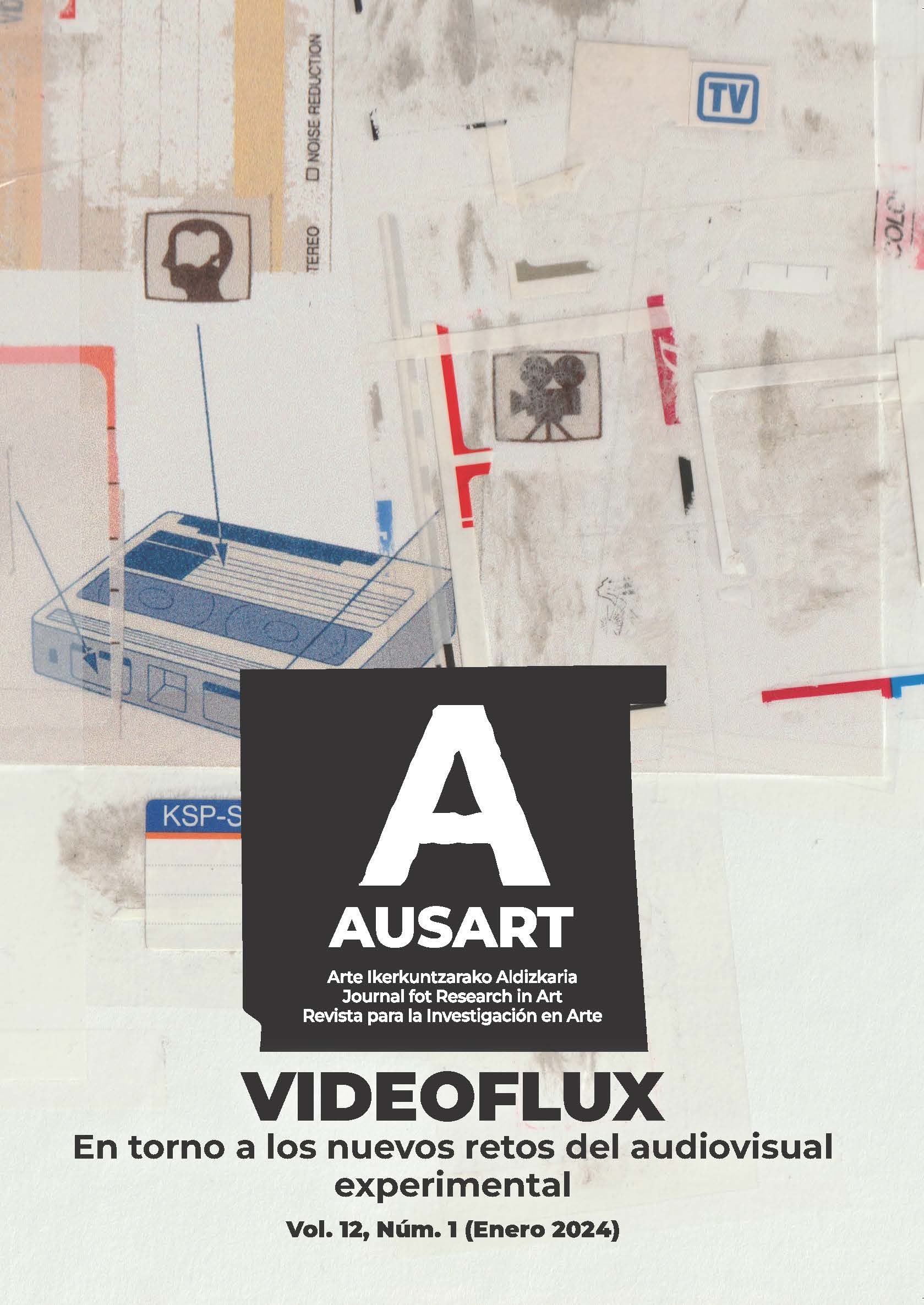Libk. 12 Zk. 1 (2024): Bideofluxa: Ikus-entzunezko esperimentalaren erronka berrien inguruan
Mugimenduan dagoen irudia jarioa da, baina baita ikusmen-arteentzako zubia ere. Artearen eta kulturaren esparruetan mugitzen ari den irudiak gaur egun duen hegemonia eta bere digitalizazio geldiezina direla eta, ikus-entzunezko esperimentalaren kontzeptua bera birplanteatu behar dugu, bai termino ontologikoetan, bai materialetan, eta baita artxiboaren nozioek hartzen dituzten zentzu berriak ere.
VideoFlux proiektutik (AKMEKA IT 638-22 talde kontsolidatua) AusArt aldizkariaren ale monografiko bat planteatzen genuenean, proiektua abian jarri zuten kezkei begiratzen genien, esperientzia berriak biltzeko eta topaketarako eta ezagutza trukatzeko eremu berriak ahalbidetzeko. Horrela, hemen aurkezten ditugun lanak panoramika ireki eta pausatua dira (film bati hasiera ematen diotenak bezala), ondare-erantzukizunak eta sormen-esperientziak elkartzen diren lurralde bati buruzkoa. Pentsamendua eta ekintza barne hartzen dituzten ikerketa-espazioak irekitzen dituen ikuspegi-gurutzaketa. Gauzatzen ari diren zenbait proiekturi buruz ari gara (Bideo Artxiboa, UPV/EHUn), denboran erreferentzia gisa oinarritzen diren ekimenei buruz (Hamacaonline.net) edo ikasgelarako material gisa balio dezaketen ikus-entzunezko lan batzuen sortze-prozesuen kontakizunari buruz. Argitalpenak, azkenik, ikus-entzunezko esperimentalaren, genealogien eta deriben, hibridazioen eta interakzioen ikuspegi anplifikatuari erantzuten dioten ekarpenak biltzen ditu.
Horrela, erakusketaren espazioarekin dituen harreman moduen bidez, irudiaren ezaugarri hedatua hainbat proposamenek jasotzen dute, hala nola Iñaki Billelabeitiarenak, obra mota horretan denboraren kontzeptua berrikusita edo Francisco José Gómez Díazek Eva Lootz artistaren «Entremanos» instalazioari buruzko testuan egindako ekarpenaren bidez.
Zinemaren, telebistaren eta bideoaren arteko gurutzaketak, hibridazioa eta iragazpen estilistikoak, eta gaikako transbaseak dira Ricardo Roncerok landu dituen gaiak, telebista-interstizioei buruz hitz egiten baitigu arterako aukera-gune gisa, eta Paz Tornero Lorenzok, berriz, ikus-entzunezko esperimentazioari buruzko ikuspegi historiko, kritiko eta irekia proposatzen du bere testuan.
Bestalde, Alba Matillaren ekarpenak zaharkitzetik ikus-entzunezko garaikidearen erronka berrietarainoko ibilbidea adierazten digu.
Bideoaren aukeren ikuspegi sozialetik, Itziar Zoritaren artikuluak ingurune komunitarioan garatutako ikus-entzunezko sorkuntzako esperientzia batera hurbiltzen gaitu, ekoizpen eredu konbentzionaletatik urrun dagoena, eta Eneko Lorentek, bere testuan, begiradaren errehabilitazioa proposatzen du, zinemaren eta dantzaren artean ezartzen diren harremanak jorratzeko. Etxeko bideoak denborak, genero estilistikoak eta ikuspegiak zeharkatzen ditu. Carlos Triguerosen eta Cristina Veraren testuek azpigenero honi buruzko begirada eguneratzen dute, ezinbestean sare sozialek sortzen dituzten agertoki berriei lotuta.
VideoFlux-en, gure talde-dinamikan garrantzia hartzen joan den beste alderdi bati erantzun nahi izan diogu, medien arkeologia deiturikoari, hain zuzen ere: zaharkitzearen problematikak, eta ikus-entzunezko materialen kontserbazioarekin, kontserbazioarekin eta berreskurapenarekin lotutako guztia, gure esperientziaren ardatz izan dira azkenaldian, UPV/EHUko Ederren Fakultatetik sortutako bideo-artxiboarekin lotuta. Mugitzen ari den irudiaren formatuen eta euskarrien segida azkarrak material fisiko ugari utzi du atzean, eta horrek euskarrien zaharkitze-prozesuetan eta horiek zaintzeko eta mantentzeko hautaketa-irizpideetan oinarritutako ikerketa-arlo berriak jorratzeko premiaren aurrean jartzen gaitu.
Orokorretik zehatzera doazen lanketetan, Paula Fernández Valdés, Carmen Moral eta Mireya Arenas eta Sergio Lunaren ekarpenek espezializazio teknikotik zein erantzukizun kulturaletik, irudiaren hauskortasunetik eta ordezkapen teknologiko geldiezinetik haratago duen iraupenetik hitz egiten digute.
Erronka horiek gai horien plangintzari, estrategiari eta ikuspegiari buruzko erantzukizunak (publikoak eta instituzionalak; teknikoak eta akademikoak) aztertzera eta konpontzera bultzatzen gaituzte. Pablo Maraviren testua funtsezkoa da zentzu horretan. Ia ale honetako editoriala balitz bezala, problematika konplexu bati heltzen dio, VideoFlux proiektuaren beraren izateko arrazoietako bati: ikusizko arteen eremu garaikideko esperimentaltasunari. Ikus-entzunezko ondarearen iraunkortasunari buruzko beharrezko kontzientzia hartzearekin batera, Milagros Valerioren ekarpena artxiboa aktibatzeko proposamena da. Performatibitatea, memoria komuna eta artxibo-lanerako irisgarritasuna bezalako kontzeptuen translazioak aukera berriak ematen ditu interpretaziorako eta Hamaca (hamacaonline.net) bezalako plataformak sortzeko, ikus-entzunezko beste biltegi batzuetara estrapola daitekeena.
Ikus-entzunezko artxiboa, gainera, biltegi bat dela jabetuta, bizitzara itzultzea espero duten irudi-multzo bat, ezin izan ditugu alde batera utzi muntatzeko eta desmuntatzeko prozesuekin lotutako ikus-entzunezko sorkuntza eta ekoizpen garaikideko beste proposamen batzuk, edo ikus-entzunezko generoen berrikuspen kritikoa egiten dutenak. Maria Muriedasen kasua da hori, narratiba sentikor eta intimistaren ariketa, ikus-entzunezko pieza baten kontzeptualizazio-prozesura hurbiltzen gaituena. Ildo beretik, Aitor Irulegiren testua praktika artistikotik eta animaziozko film laburraren ekoizpen prozesuari lotutako pentsamenduetatik sortu zen.
Ivan Perezek kontatzen duen 143D Jaialdiaren esperientzia elkarlaneko (eta dagoeneko historikoa den) ekitaldi baten kronika da, pultsio sortzaile eta gogotsu horretatik bertatik eraikia.
Ikus-entzunezko esperimentalaren erronka berriak programazio bisualeko lengoaietatik, robotikatik edo adimen artifizialetik datozen ekarpenak ulertzea dira. Regilene Sarzi Ribeiroren eta Ana Sedeñoren testuak, eta José Antonio Vertedorrenak, artearen eta ikus-entzunezko baliabideen aukera-eremu horren guztiaren leiho dira.
AusArt-en zenbaki monografikoko testuen aukeraketak bide berriak irekitzen laguntzen du, bideoa arte- eta kultura-ondare gisa zaintzeko, kontserbatzeko eta berreskuratzeko lanetan sakontzeko, eta gai horiei buruz gogoeta egitera gonbidatzen du, esparru akademikoa gainditzen duen publiko zabal bat: irakasleak, ikasleak, artistak, komisarioak... Horrez gain, esperimentazio artistikoaren esparru horretako audientzia berriak eta zabalkunde-foro berriak.
Arturo-Fito-Rodríguez Bornaetxea
Gabriel Villota Toyos
Monografikoaren koordinatzaileak (VideoFlux proiektua)
Argitaratua: 2024-01-31

